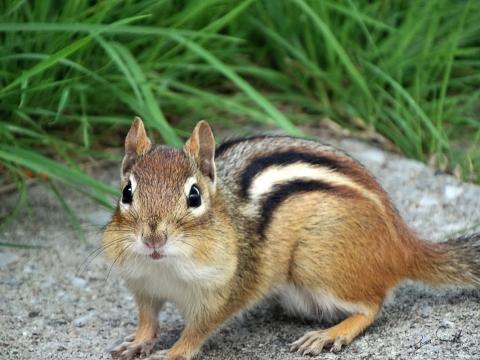Chipmunks in the Garden

By the sound of things, eastern chipmunks have taken up residence in your garden. Chipmunks are eight to 10 inches long, have five long conspicuous dark stripes that run down their sides and backs, and have flattened furry tails. They also have light colored stripes above and below their eyes, and cheeks with large pouches that can store and carry food. They live throughout the entire state of New Hampshire and are just as likely to be found in backyard gardens as they are in open, deciduous woodland environments. No matter where they are found, chipmunks create burrows with extensive networks of tunnels and entrances that are used for shelter and storing food for the winter months. Burrows are frequently constructed on slopes, aiding in quick water drainage after storm events.
Chipmunks are omnivores, meaning they will eat a wide variety of foods. Depending on what is readily available, they will consume roots, seeds, acorns, mushrooms, insects, earthworms, bird eggs, and occasionally baby mice. Chipmunks become a nuisance in the garden when they eat the berries, fruits, vegetables, and bulbs we plant. Many gardeners can attest to the fact that they are especially fond of strawberries, tomatoes, and tulip bulbs. A heavy chipmunk population can drastically reduce the amount of flowers and quality produce available for harvest in home gardens.
If chipmunks are a problem in your garden, there are a few different things you can do to control them. Start by trying to modify their habitat by reducing or restricting their access to available food. You can prevent root or bulb feeding by placing vulnerable plants inside of hardware-cloth enclosures at planting time, or instead, choose bulbs such as daffodils or crocus that are not attractive to chipmunks. Chipmunks are also frequent visitors beneath bird feeders. If you haven’t done so already, take down feeders and do not replace them until the chipmunks (and bears) have gone to sleep for the winter. When removing food sources isn’t enough, shooting (where legal) and quick-kill traps are the more humane methods of reducing chipmunk populations*. Rat traps baited with peanut butter can be an effective means of eliminating individual problem animals.
* Live trapping chipmunks is not recommended because the release of small animals like chipmunks into unfamiliar territory with no shelter (burrows) exposes them to predators and possibly starvation.
Got questions? The Ask UNH Extension Infoline offers practical help finding answers for your home, yard, and garden questions. Call toll free at 1-877-398-4769, Monday to Friday, 9 a.m. to 2 p.m., or e-mail us at answers@unh.edu.
